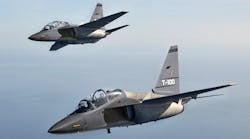Boeing Defense, Space & Security has a new, $2.8-billion U.S. Air Force contract to start low-rate initial production for two “production lots” of the KC-46A tanker aircraft. The first lot involves seven aircraft, while the second covers 12 aircraft. Including future options, Boeing expects to build 179 of these refueling and strategic airlift aircraft for the USAF.
This step follows a Defense Acquisition Board review and announcement that the KC-46 program completed “Milestone C” (a series of ground and flight tests) and is approved for initial production. Those tests included refueling flights with F-16, F/A-18, AV-8B, KC-10, C-17, and A-10 aircraft and a cargo handling demo.
The KC-46 Pegasus was developed by Boeing for military aerial refueling and strategic military transport, and is based on the twin-engine, wide-body platform long occupied by the 767 passenger jet program. In 20111, the design was selected by the USAF in a competition to replace its KC-135 Stratotanker aircraft.
According to the OEM, the KC-46A can refuel all allied and coalition military aircraft compatible with international aerial refueling procedures, and can carry passengers, cargo and patients.
Boeing is assembling the KC-46 aircraft at its Everett, Wash., complex, and the first 18 jets are due to be delivered by August 2017.
“The KC-46 tanker will provide the Air Force unprecedented refueling capabilities, operational flexibility and combat readiness,” stated Boeing Defense president and CEO Leanne Caret. “It’s an important day for the company and program. We’re excited about building low-rate initial production aircraft, and it’s only possible because of the hard work of the joint Boeing-Air Force team.”










